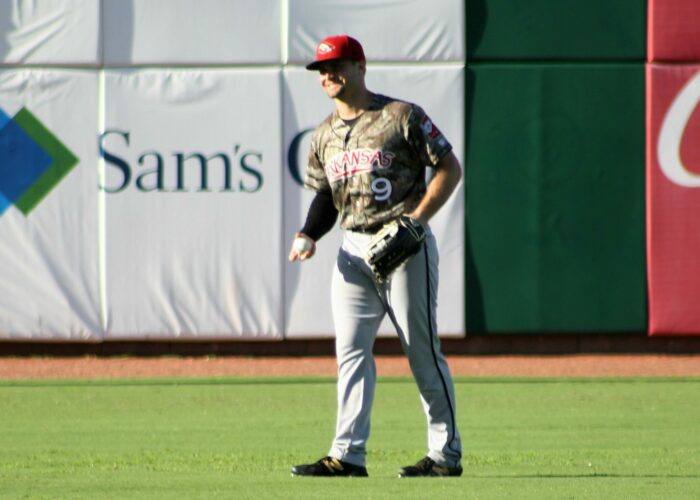
Every offseason, teams pick up player of minor league contracts to help fill out the rosters in their system. This year, one of the first players new Mets GM Brodie Van Wagenen picked up was 1B/OF Dario Pizzano.
To the average fan, this signing doesn’t seem that notable. I have learned that the players that aren’t that known always have a better story to tell and have very intriguing backgrounds to them.
Pizzano, originally a 15th rounder in the 2012 draft, has spent all seven of his pro years in the Seattle Mariners organization. He went to college at Columbia University in New York City which makes this a homecoming of sorts. Dario enjoys being able to use his college’s facilities to train in the offseason which is even easier now that he is on New York. He was born and raised in Boston so the big city life is nothing new to him. The fit with the Mets was almost perfect.
Dario has never been a superstar player as he has always been an average hitter and average defender. Last season at Double-A Arkansas, he hit .285/.361/.433 with 11 home runs and 59 RBIs through 107 games. He played 13 games at first base and 23 in left field.
For his career, Dario has hit .283/.363/.434 with 53 home runs and 361 RBIs through 690 career games. He’s always put the ball in plat at a high rate, striking out only 311 times in 2435 at-bats.
I had the privilege to interview Dario to get to know about his background and about the game of baseball in-general.
MMN: Hey Dario, how’s your offseason been?
Pizzano: Hey, how you doing, I’m doing well, been a long offseason, obviously happy about the new opportunity with the Mets but I’m ready to go, ready to get working on the 2019 season.
MMN: First thing is that you went to Columbia University, how cool is it to be close to home again?
Pizzano: It’s awesome. Honestly, I’ve always wanted to be on the east coast. When I was playing in the minors with the Mariners all their affiliates were west coast and the closest I think I played was 2013 in Clinton, Iowa, so it’s really not — it hasn’t been close.
I’m from Boston originally, the Boston area, and going to school in New York City I love everything about the city. I’ve been to Yankees games, I’ve been to Mets games while I was in school with some of my friends and Citi Field, the new Citi Field, is awesome, and I can’t wait. Hopefully, I get to play on the surface and in the field myself as one of the players for the Mets so it’s awesome to be able to have family and friends and my girlfriend come more often to see me play.
MMN: How have things changed in baseball since you were drafted by the Mariners in 2012? Because obviously we all know about sabermetrics and analytics, but as a player how much of the way everything is run behind the scenes has changed since you got drafted initially?
Pizzano: Definitely, it’s changed a lot. It’s definitely first how you mentioned all the advanced metrics and all the sabermetric stats and the StatCast and all the exit velo and launch angle, all that stuff’s come on in the last few years. When I got drafted, it was kind of new and it was starting to get that way a little bit but the last three or four years it’s really — I mean, there are stats that I don’t even know what they mean, so like I’ve seen numbers on myself that I don’t know what that means, you know? Like wRC+, all that kind of good stuff, so I mean, it is good. I think that it’s good and bad, you know obviously there’s the more information that you have and the more information that you can process on every player, obviously, it’s beneficial to each team.
I also think sometimes that you know, intangibles get lost in that. You know, people — you’re just like a number, the leadership, hard work, all that kind of stuff kind of gets out of the equation but you know, it’s new and it’s exciting. And as for it’s still kinda going that way, still on that same subject kind of with all that new information, at every level they have so much more information now. Like when I was in Rookie ball, we didn’t even have any scouting report on the opposing pitcher.
Now all the way down they have video and pitch sequences and scouting reports and all these advanced stats on all these pitchers and hitters. It makes it much better as a player to get that information, it makes you way more prepared. It’s also harder, because as a hitter, right in my first at-bat the defense knows where I’m gonna hit it, the pitcher knows where my strengths and weaknesses are, so there’s a ton more information and I think overall it’s beneficial because the more information you have it’s gonna help teams more.
MMN: Which one of the metrics, stats, or analytical components do you look at most and which ones do you like the most?
Pizzano: Honestly, like I try for mental purposes during the season to not look at my stats at all, because, I mean, everyone says that and I’ve always been a huge stat guy, quote-on-quote, because when I grew up, and when I was playing coming up, I wasn’t the prototypical prospect player, so I had to put up numbers to move on, you know? So I was always aware of my numbers and stats.
Then as I got higher and higher into pro ball, I mean that stuff could easily spin out of control, it could get into your head and like, instead of going 0-for-4 one game I would let a 0-for-4 turn into a 1-for-20 because I was aware of my numbers. So I try not to look at it but I mean, I’ve heard that one of the major new stats that teams look at is wRC+, weighted runs created plus.
That takes into account the field that you’re playing at a little bit so it kind of — you know, if you’re playing at a hitter’s field and a guy has fifteen home runs and then if you’re playing at a really big pitcher’s type field, and you have ten, they even that out a little bit and it takes into account like on-base percentage, all that good stuff, so I think that that’s one that a lot of teams are looking at as one of the most important ones.
MMN: Did you get any other offers from any other teams?
Pizzano: Well I signed pretty early, I was really glad to get it not over with. The Reds had called, I think the Rangers and the Marlins, but it wasn’t the interest– the Mets showed immediate interest right away and they were like “We’re really interested in signing you.” The other teams were kind of like “Yeah, you’re on our list, we’ll circle back around, and we’re gonna keep you at the hunt. So yeah, I heard from a couple, but the Mets were definitely from day one, they were the most interested.
MMN: You’ve been a pretty consistent hitter during your career, what has been your key to success and staying resilient throughout your entire career?
Pizzano: Yeah, so I’ve always been a hitter even in Little League, high school, and even college where I really had a feel for the strike zone. I’ve always walked a lot and never struck out that much. I always grew up thinking the more you put the ball in play the more chances to get a hit. I also had a good eye at the plate so that allowed me to have a lot of walks and not a lot of strikeouts.
Back in college I could cheat and pull the ball because we still had metal bats, but pitchers are taught that the hardest pitch to hit is low and away so if I master that then they would have to throw it in over the plate and I could react to an inside pitch. Obviously, in baseball, you are going to have highs and lows. Some seasons are better than others and the first time I went from High-A to Double-A was a huge adjustment for me and that first year in Triple-A where I wasn’t playing every day and I was pinch-hitting was a huge challenge for me so.
MMN: You mentioned the adjustment to Double-A, is that a tougher adjustment than going to Triple-A?
Pizzano: I think that they are different. I wouldn’t say that Double-A is easier or harder, it’s just different. The younger prospects, with better “stuff”, throwing over 95 both starters and relievers, and I faced guys like Dennis Santana or Caleb Ferguson of the Tulsa Drillers before they got moved up and they had really good arms, the guys from the Astros, the Corpus Christi Hooks, they are young and the starters are throwing 95-100.
They tend not to have the pitchability of the guys in Triple-A or the big leagues. They have the stuff they just can’t necessarily pitch backward, they can’t locate. In Triple-A there is a lot of ex- MLB players or AAAA guys that are up and down and don’t have the “stuff” but they can pitch better with not as electric stuff like a 2-0 curveball.
The thing that was hard in Triple-A was that I was facing Matt Cain or Tim Lincecum at the end of their careers. They are trying to make it back and they were throwing to me, the 8th hitter, a cutter not necessarily a fastball. The overall talent in Double-A is a lot better than Triple-A but I think that they make fewer mistakes and have better pitchability in Triple-A.
Part 2 coming soon!
You can follow Dario on Twitter at @DarioPizzano25

